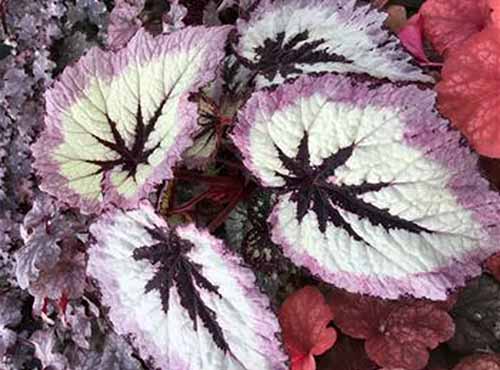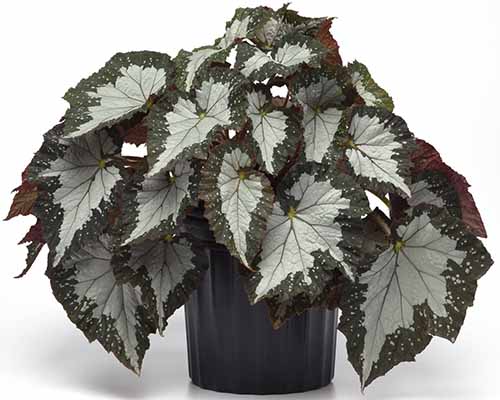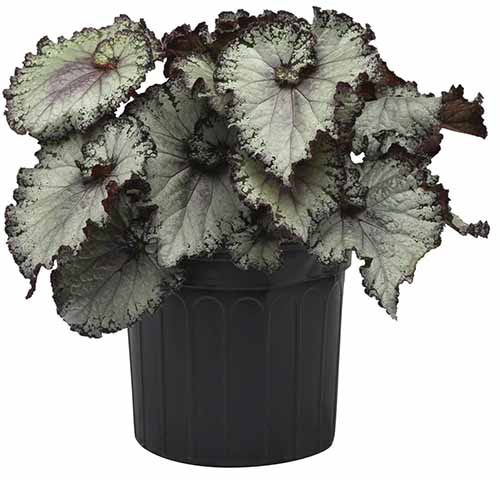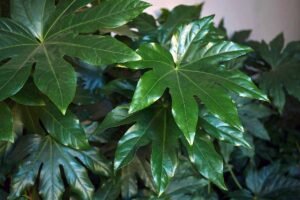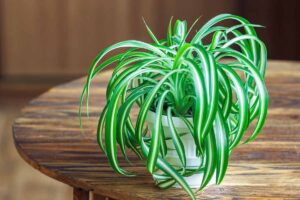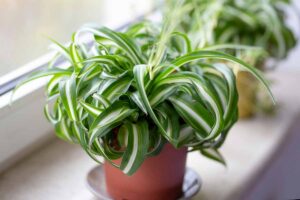Begonia x rex-cultorum
Rex begonia houseplants, Begonia x rex-cultorum, are living art – richly colored, dramatically patterned, vibrant, and perhaps shimmery, depending on which type you grow.
Contemplating their puckered, crinkly, whorled leaves can challenge a dour mood or your preconceptions about botanical shape and color.
I own several of these museum-quality indoor begonias, and I enjoy them so much I am willing to provide the moderate to high maintenance they need to thrive.

We link to vendors to help you find relevant products. If you buy from one of our links, we may earn a commission.
Outside of USDA Hardiness Zones 10 to 12, rex begonias are commonly grown as houseplants that may spend the warm months outside.
They may also be grown outdoors as annuals. It can be tricky to provide the humidity they prefer and to deliver the specific amounts of light and water they require.
Are rex begonias easy to care for? Not really. Are they worth the extra effort? Absolutely.
But don’t take my word for it, or at least not yet. Let’s get to know this hybrid begonia variety better before you decide whether it’s the houseplant for you.
I’ll try to keep my gushing to a minimum as I share tips for growing and caring for rex begonias, but I can’t promise. Here’s what I’ll cover:
What You’ll Learn
What Are Rex Begonias?
Rex begonias are herbaceous hybrids most often grown indoors. They are hardy perennials suited to outdoor growth year-round only in USDA Hardiness Zones 10 to 12.
In this guide we’ll focus on growing this variety as a houseplant, whether you choose to move it indoors in the cool months or maintain it inside year round.
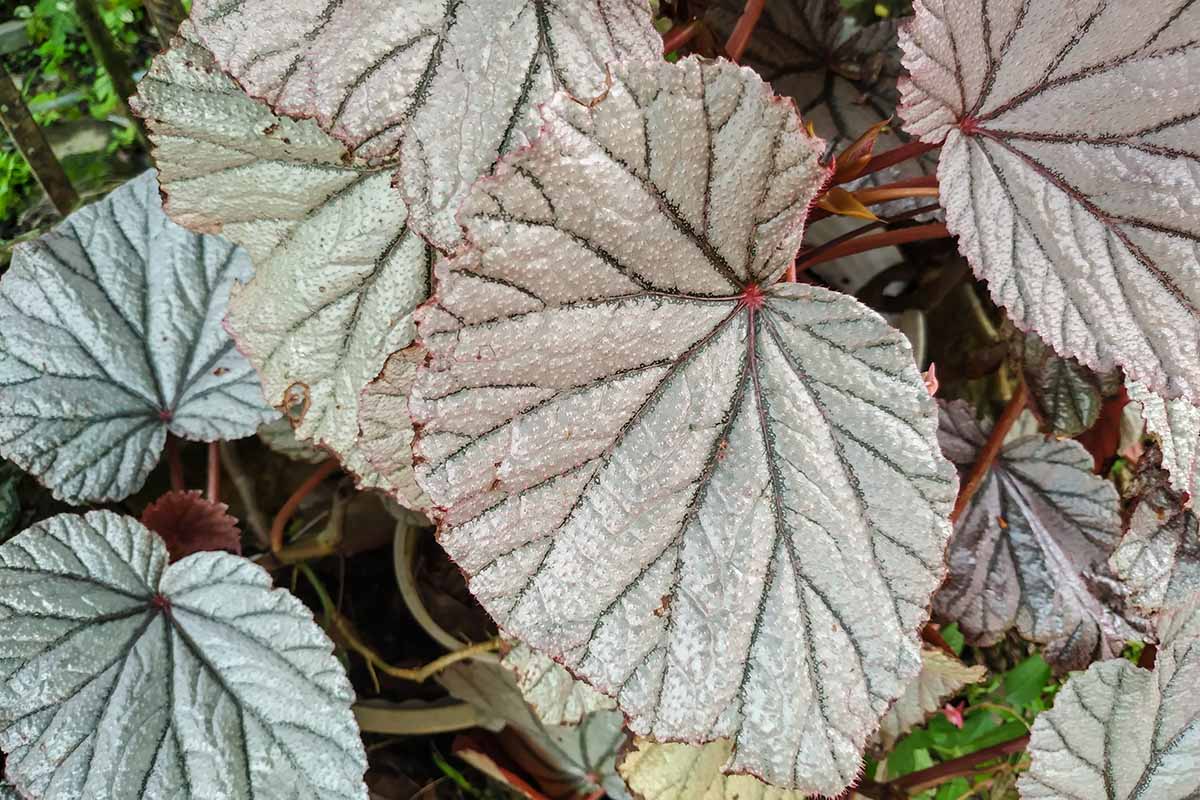
Rex begonias are renowned for their showy leaves. The blooms that they produce are tiny, and considered insignificant.
Most varieties spread via rhizomes. But rex begonias are classified separately from other rhizomatous begonias because they have showier leaves and demand a higher level of care.
Most of these subtropical plants have dense, rounded, or teardrop-shaped leaves that grow three to six inches long or wide, depending on the variety.
Many types have a metallic surface or are silver-colored, while others have what I would call a matte finish in green, gray, or pastel hues.
Crinkled, puckered, or veined leaves distinguish other varieties, which can also sport splotches, pronounced veins, or contrasting-color leaf margins, alone or in combination with other patterns.
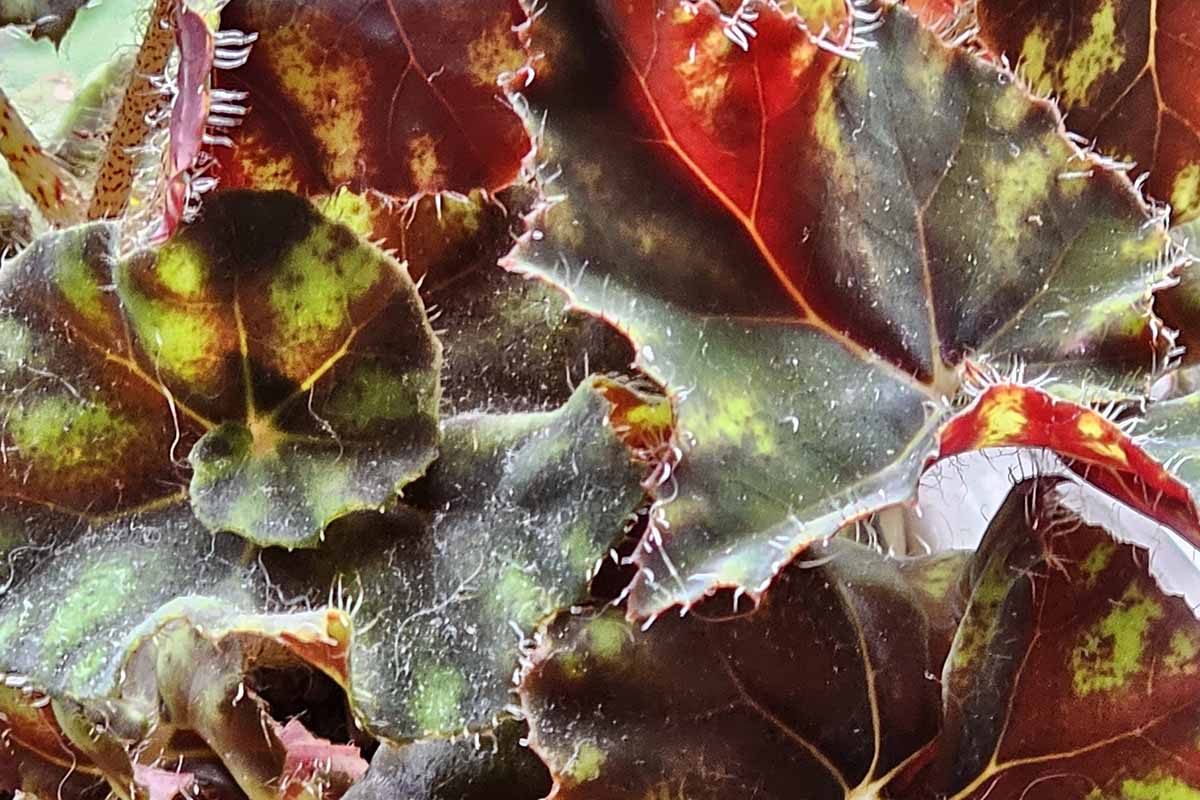
To name all the possible leaf colors and combinations would make me sound like Bubba Blue reciting possible shrimp preparations to Forrest Gump, but a few of my favorites include lavender, cream, deep red, gray, and taupe.
It’s easy to see plant breeders have had a field day with rex begonia hybridization, and you should look forward to lots of beautiful, sometimes zany patterns and colors among the more than 500 named cultivars in this group.
Before you start a list of your favorite patterns, let’s delve into the history of this striking houseplant.
A Note of Caution:
Rex begonias contain an insoluble calcium oxalate that is toxic to dogs and cats.
While some is produced in the leaves and stems, the highest concentrations are found in the rhizomes and roots below the soil surface.
Symptoms of poisoning in dogs and cats include vomiting and salivation. If your pet has ingested any portion of your houseplant, call your veterinarian immediately.
In addition to keeping the plants where pets can’t munch on them, make sure kids won’t be tempted to sample one of the pretty leaves.
One nibble will cause an unpleasant sensation in the mouth, so people and most pets are unlikely to continue eating after that bit.
If you’re repotting or rooting rex begonia rhizomes, wear gloves to avoid skin irritation.
Cultivation and History
B. x rex-cultorum belongs to the Begonia genus first described by Franciscan monk and botanist Charles Plumier in 1700. At least 200 species had been identified as of 1850.
One type of begonia, B. rex, was native to the northeastern Indian state of Assam and brought to England in 1856.
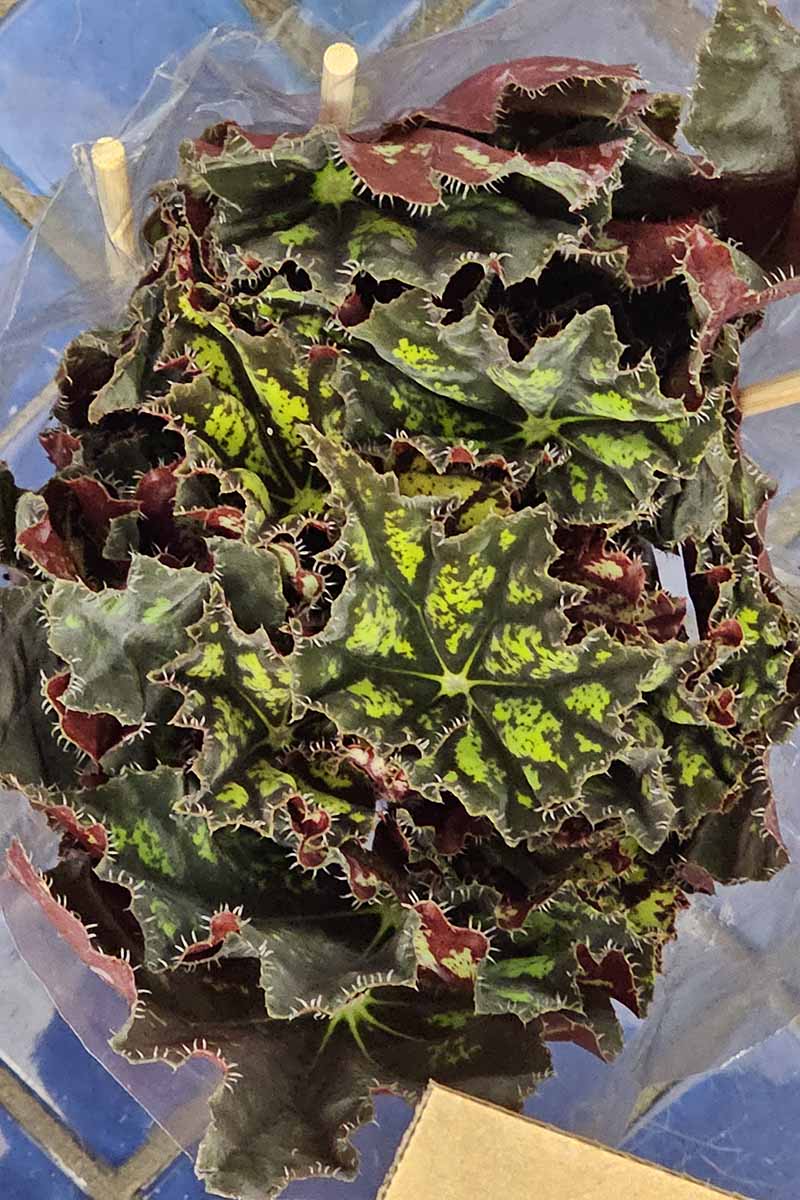
A perhaps apocryphal story has Belgian horticulturist Jean Linden coming across the fabulous leaves of wild B. rex growing intertwined with an orchid brought to a London auction room.
Linden purchased the orchid and begonia together and offered B. rex for sale commercially in 1858.
The rex begonia we know today in cultivation is not this wild B. rex but one of many hybrids bred with B. rex as one of the parent plants.
The Rex Cultorum group was first described in 1920, but the number of varieties available has increased exponentially in the intervening century.
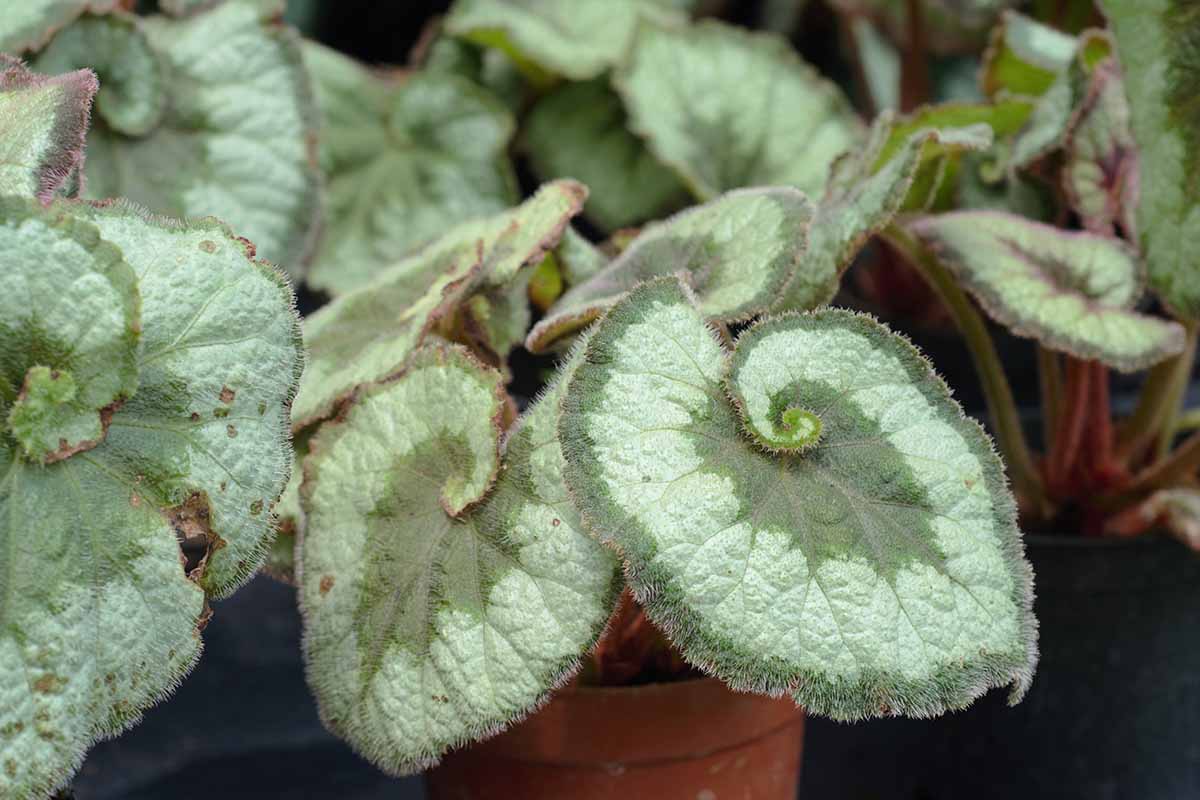
Varieties that resulted from a cross with B. evansiana were taller, and other crosses created cultivars that grew upright or had brilliant red leaves, spiral patterns, or leaves with velvety surfaces.
One handy way to categorize them is by size.
The leaves of the small types are about three inches in diameter, medium range from three to six inches, and the large rex begonias have leaves that are six inches across or larger.
Most cultivars are rhizomatous, but a few are not.
Breeders and commercial growers are still having a field day with rex begonias. Newer cultivars follow popular home design color trends and offer hundreds of different patterns and shapes. But don’t let this wide array make you dizzy!
You’ll only need one or two rex begonias for dazzling winter color indoors, or to enliven a patio container garden during the summer to return to a sunroom shelf in the winter.
Happily, with all the color, patterns, and shapes available, you’re bound to find a combination that suits you, and that’s available for sale.
Rex Begonia Propagation
Whether you’re new to this indoor plant or have discovered a variety you want for your own, there are instantaneous as well as more leisurely ways to propagate rex begonias.
From Seed
Unfortunately there are three strikes against attempting to grow rex begonias from seed.
First, the plants are hybrids, so those that germinate from saved seed will not grow true to the parent plant.
Second, the seeds are practically microscopic, so they’re nearly impossible to handle carefully for planting.
Third, seeds are generally unavailable commercially.
And if you manage to overcome those three obstacles by saving seeds independently, working with tweezers and a magnifying glass, it will take at least six months of TLC to generate a plant. (Oops, that makes four strikes.)
But maybe you’re up for a challenge? Sowing seed can also result in new and wondrous cultivars, the product of pollination and sexual reproduction.
If you’ve been able to find or save seeds and want to give it a go, find general instructions for starting seeds indoors in our guide.
But do keep in mind that rex begonia requires light to germinate, so the seeds should rest on the surface of the growing medium.
From Rhizomes
Instead of wasting time and energy on seed starting, I’d recommend buying small plants to grow to maturity or cutting parts of the rhizomes to root if you already have access to mature specimens.
If the rhizomes already have roots and foliage attached, you just need to pot them up and watch them grow!

Use a clean paring knife to slice a leafless piece from the end of the rhizome, then lay it on a clean surface out of sunlight to dry for a few hours or overnight.
Place the rhizome cutting on top of a pre-moistened, porous, peat-based potting mix in a small seed-starting cell or pot with drainage holes.
Press it so the root side of the rhizome is below the soil surface and the top part peeks above.
Place the container in a humid spot with bright, indirect light and keep the growing mix moist but not damp with a spray bottle. The rhizome should start growing roots and leaves within a few weeks.
You can hasten the process by arranging a plastic bag or terrarium top over the container to hold in moisture.
The process is quicker still if a plant in your possession already has rhizomes with roots and perhaps a few leaves that you can divide and repot.
This is a task best done during the growing season in late spring or summer so the plants have a chance to regenerate before winter dormancy.
Gently tip the plant from its pot, brush some dirt from the roots, and sever sections of the rhizomes with leaves and roots attached.
Repot them immediately in the same growing mix and shallow pots you’d use for older plants.
They should adjust to their new situation and resume growth within a week.
From Leaf Cuttings
It takes consistent tending and about six months to propagate viable rex begonias from leaf cuttings, but that’s often the best way to grow more of a beloved cultivar or expand your collection when other collectors live nearby and are willing to share cuttings.
Snip off a leaf at the base of the stem, and remove the stem. Make four to five small, quarter- to half-inch cuts through the main veins on the underside of the leaf.
Prepare a shallow pot filled with moist potting soil, and pin the leaf onto the surface of the soil using propagation pins, like these available via Amazon.

Gently mist the surface of the leaf and keep it in a warm, humid location, misting daily.
After about six to eight weeks, you should see small plants emerging from the leaf cuts. When they are around three to four inches tall, you can transplant them into individual pots.
Transplanting
When rooted cuttings or purchased plants are ready to go in new containers, scoop out enough soil so you can place the rhizome so it’s about halfway visible above the soil.
Backfill with potting mix and firm it with the heel of your hand. Wait to water it in until the next day.
For the occasional rex begonia variety that doesn’t grow via rhizomes, plant so the stem is at the same height as it was in the pot or cell it’s already growing in.
How to Grow Rex Begonia
You don’t need any special abilities to grow rex begonias indoors, but you do need to plan ahead.
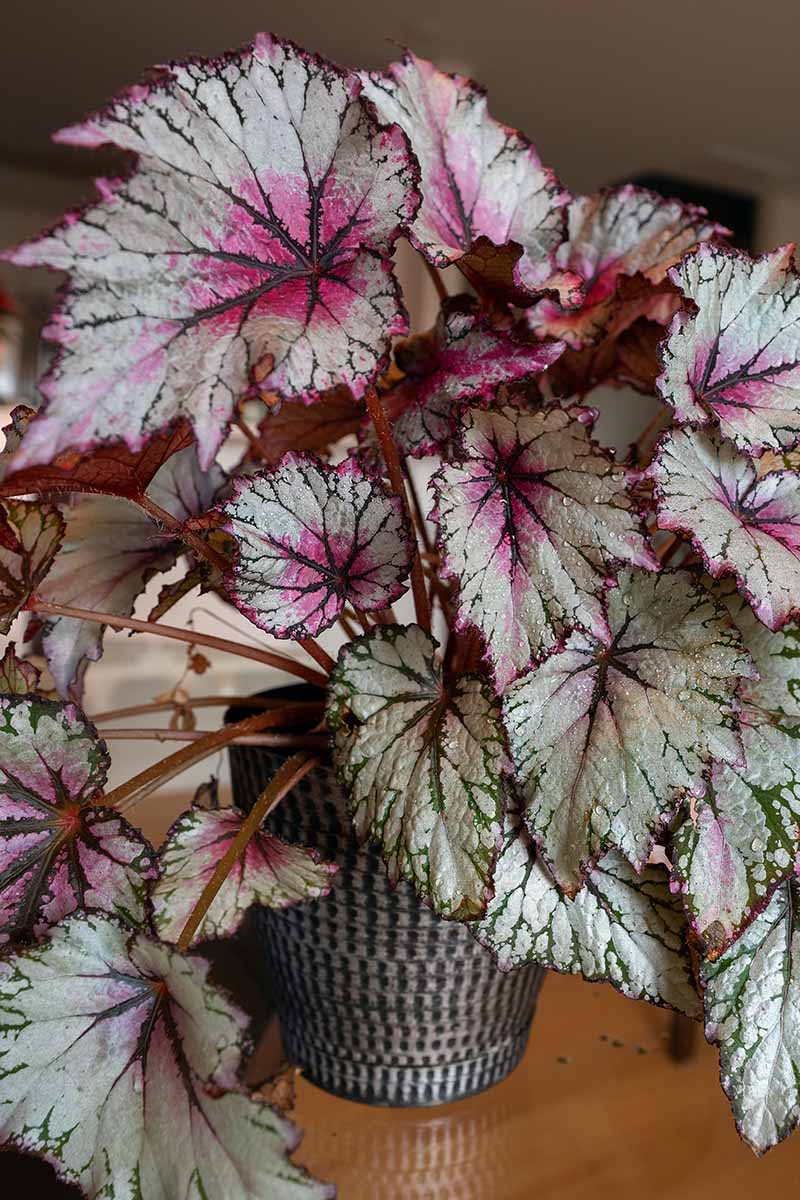
When you meet their growing requirements, they’ll usually respond by producing beautiful foliage and thriving for at least three years.
And once you catch the hang of how caring for rex begonias differs from growing other subtropical houseplants – and other begonia species – it gets much easier to keep the plants happy and healthy.
These are the areas to focus on:
Soil
The first step is providing a suitable growing medium. All varieties of B. x rex-cultorum grow best in a porous, peat-based medium that will drain easily.
You can use a growing mix specially formulated for African violets straight from the bag.

A two-pack of eight-quart bags of African violet potting mix is available from Miracle-Gro via Amazon.
If you have an ordinary potting mix available, you can amend it with perlite and/or commercial compost to improve drainage.
Containers
Most rex begonia varieties are rhizomatous. You’ll want to choose a shallow, wide container with drainage holes so the rhizomes can spread and sprout leaves, and the shallow soil can drain freely.
They don’t mind if the pot is larger than the root ball, but once the rhizomes start pressing against the sides of the container or spilling over, it’s time to prune, divide, or repot.
I like the shallow unglazed terra cotta pots you sometimes see marketed for growing succulents or sold as “bulb planters.”
Potting mix in unglazed clay dries out quickly, which is good since plants in this begonia group are susceptible to root rot from overwatering.

A suitable terra cotta pot eight inches wide and just under four inches tall with drainage holes and a saucer is available from Amazon.
Learn more about choosing pots or other containers for plants in our guide.
Light
This is one of the more demanding aspects of growing rex begonias, especially any that will spend all their time indoors. You see, they need plenty of light, but they can’t handle direct sunlight.
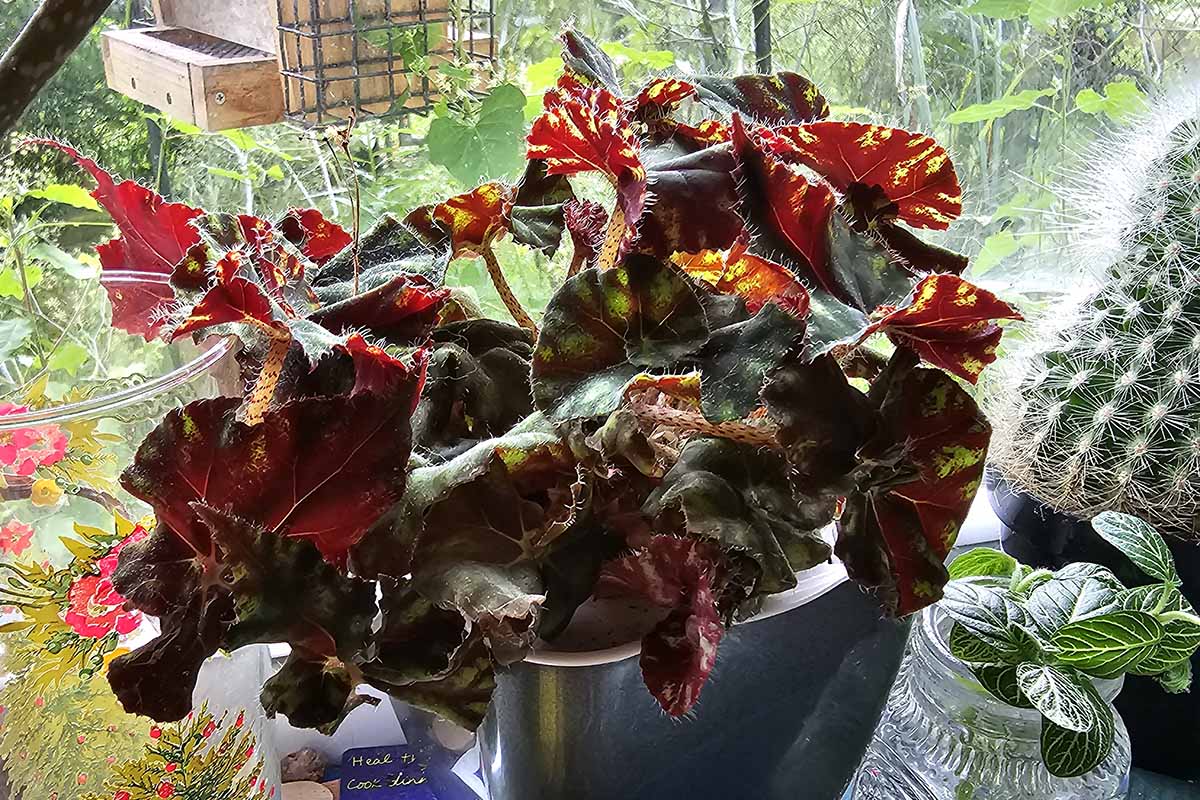
You must provide a spot about a foot to five feet from a sunny window, or in a window that receives bright light but isn’t exposed to direct rays.
You may need supplemental grow lights indoors to deliver the right amount.
If you do place the plants near a sunny window that only casts light on one side, rotate the pots a quarter turn once a week so the plant doesn’t become lopsided as it grows toward the light.
If your rex begonias will spend the warmer months outdoors, they can handle a part or even full shade location.
Gradually get them used to the reduced light with a week or so of “hardening off” before sending them outside full time. They can’t tolerate direct sunlight any better outdoors than they can inside, so choose their location wisely.
Temperature
Temperatures around 70°F by day and 60°F overnight will encourage the best growth.
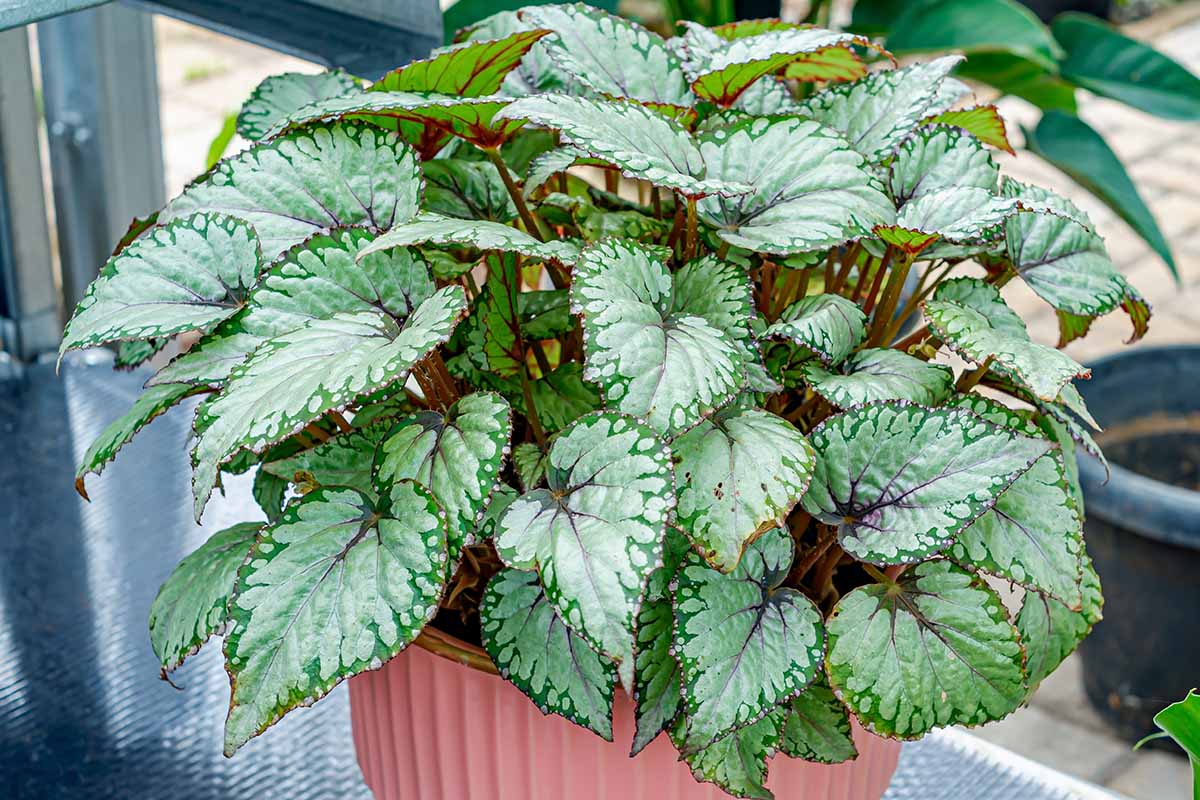
You can move the plants outdoors for the warm months, but only once the temperature is reliably above 60°F at night. Bring them back inside a few weeks ahead of predicted cool weather.
Gardeners with scorching hot summers also have to worry about high temperatures if bringing plants outdoors.
If temperatures exceed 80°F, the plants will be happier indoors in a controlled climate.
Humidity
Temperatures in the desirable range, an ideal potting mix, and perfect lighting will all mean little if you can’t provide ample humidity for rex begonias.
They like 50 percent or more, and the leaves will quickly develop brown edges or die off when the humidity isn’t ample.
Indoors, you can elevate humidity levels by placing plants in the kitchen or bathroom, where it’s usually more humid than the rest of the home.
Or consider placing a saucer of water and pebbles beneath the pots to evaporate and increase moisture in the air. Just make sure the bottom of the pot rests on the pebbles without making contact with the water so you don’t drench the roots.
While it may seem like a good idea, don’t mist the plants directly or they’ll risk contracting powdery mildew caused by wet leaves. Also, spraying only increases humidity effectively if you can do it several times a day.
If you are really committed to providing that 50 percent humidity and live where the weather or the winter air is dry, you might want to consider using an electric humidifier.
Water
The careful choice of container and potting mix pays off when it comes to providing optimal moisture levels.
Rex begonias need consistent moisture, but the leaves will turn yellow and the plants could develop root rot if you overwater.
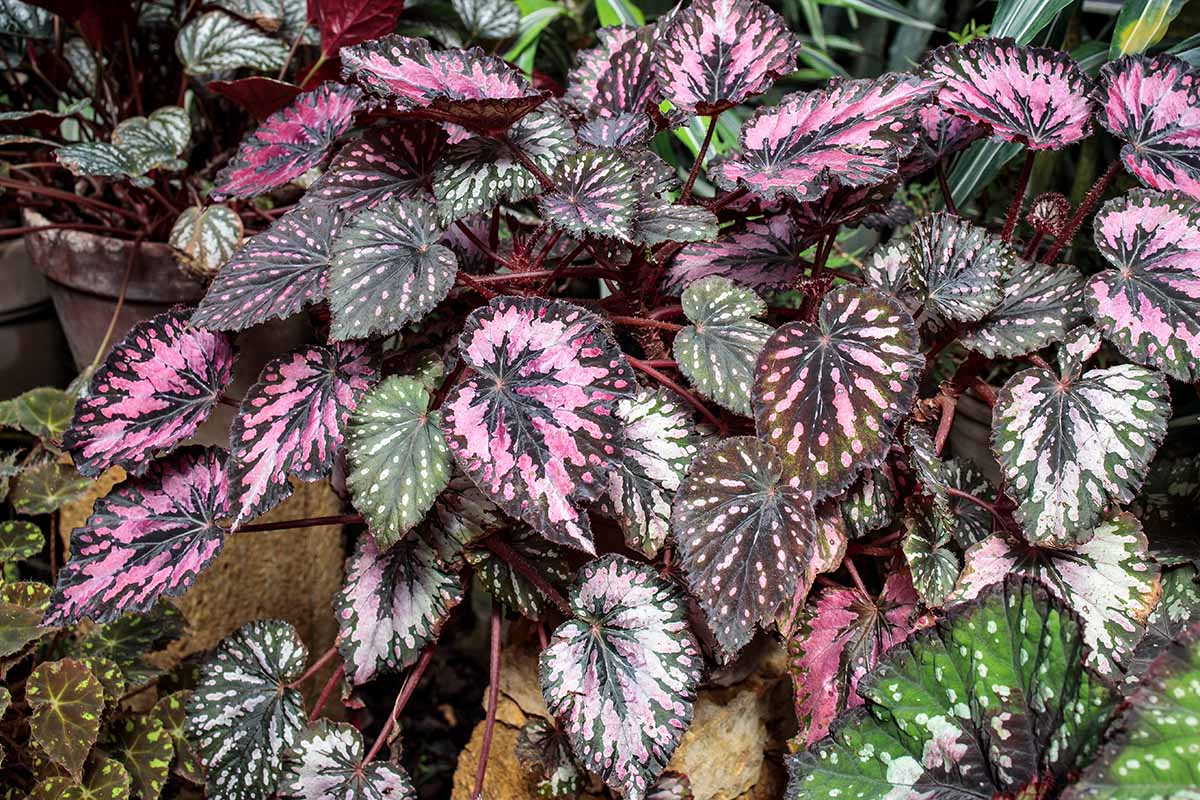
Aim to provide soil that feels evenly moist, not overly dry or soggy. It’s a good idea to use a watering can to water at the soil level.
Fill the planter until excess runs out of the drainage holes at the bottom and then let it drain for another 15 minutes or so.
Be sure to discard water that accumulates in the saucer below. Rex begonias don’t like wet feet.
Between waterings, let the top inch or so of the soil become dry, using a moisture meter or your pinky to check.
If you have hard water like I do, ensure your potting mix is well-draining. Coping with salt deposits from hard water will weaken the plants. Consider using filtered water instead.
Fertilizing
Provide a balanced liquid fertilizer once a month throughout the spring and summer growth period, making sure to water the plants and let them drain before and after application.
Once the plants enter dormancy in late fall or early winter, you can cease fertilizing.

One good option is Bonide’s 10-10-10 NPK liquid plant food, available in an eight-ounce container via Amazon.
Growing Tips
- Grow in high humidity of at least 50%.
- Provide temperatures of 70°F during the day and 60°F at night for optimal growth.
- Place in bright, indirect light, away from direct sunlight.
- Rotate pots a quarter turn once a week to encourage fullness.
Pruning and Maintenance
A couple of maintenance chores are critical for healthy, colorful rex begonia foliage.
Always remove any dead leaves from the surface of the soil as soon as you notice them. This will keep diseases and certain insect pests at bay.
If you are growing the plants outdoors in the warm months, make sure to bring them indoors once temperatures below 60°F are predicted.

They aren’t remotely frost tolerant, and while they could probably live happily outdoors at somewhat lower temperatures, there’s no gain from pushing the limits – if they get too cold, they’ll die.
Be sure to check outdoor plants for bugs before you bring them inside.
When you’ve chosen a rhizomatous type, note when the rhizomes reach the sides of the pot. At that point, you’ll need to either repot into a container a few inches wider or snip some of the rooted rhizome sections to propagate new plants.
The other types of rex begonia will benefit from repotting once the stems are so close to the edges of the pot that the soil no longer captures moisture or drains properly. Be sure to choose a container just a size or two larger than the previous pot.
You won’t need to prune unless you’re growing an upright variety, in which case you should clip off the stems at the crown when leaves are showing brown tips.
Some folks also like to prune a few stems from the upright types to keep them from outgrowing their containers.
You don’t need to pinch tips when the plants are a few inches tall, but it will encourage branching.
Rex Begonia Cultivars to Select
Just thinking about all those colorful, pretty, no-two-varieties-alike types of B. x rex-cultorum makes me smile.
But don’t get too hung up on a specific cultivar – or at least try to limit yourself to only a couple of “must-haves.”
I mention this because there are scads of varieties out there, some with trademarks or catchy cultivar names, but a specific type isn’t always easy to find if you have your heart set.
Happily, there are usually other varieties that look quite similar or have the same color scheme, and these lookalikes may be waiting at your local nursery or an online venue.
In my experience, dozens of different rex begonias are sold without a specific cultivar name – only a tag that says “rex begonia” with an intriguing and colorful foliage plant in the pot beneath it. I have several of these, and they’re beautiful.
Some reputable growers also sell “grower’s choice” bundles of three to five types. They are fun and affordable, but the seller picks which ones you receive from their inventory.
For those seeking named cultivars, I recommend these:
Harmony’s Fire Woman
‘Fire Woman’ from Harmony Begonias is a good variety to start with, or as I would say, a suitable gateway plant for becoming obsessed with rex begonias.
It is lively and pretty without being overly dramatic, and its patterns and colors are more subdued than those of other varieties you may want to try once you have more experience with B. x rex-cultorum.
Growing eight to 14 inches tall and spreading six to eight inches in a mounded shape, it will readily fill an average-size pot with its periwinkle-edged, purple-veined, silvery-white leaves that sport a deep purple fireburst radiating from each center.
‘Fire Woman’ will complement vining or upright indoor plants that are mostly green or a solid color.
Once you’ve had a chance to admire its beauty for a few weeks, you may be ready for other varieties with bolder reds or metallic sheens, twisted or deeply cut leaf shapes, or brazen patterns.
Or perhaps this mild-mannered rex begonia will steer you towards others with ordinary-shaped, round leaves, or subtler hues of moss green or taupe. Who knows?
‘Fire Woman’ is available in a four-inch pot from Sacred Roots Nursery via Walmart.
Harmony’s Venetian Red
The painterly splotches of green, light red, and dark pink on this variety’s heart-shaped, crinkly, jagged-edge leaves would be at home in an Impressionist painting.
The brighter the light, the more pronounced the red hues become, while low light encourages a signature rex begonia metallic sheen.
This is a nice choice for a desk or bookshelf that offers indirect light since it grows a relatively compact six to eight inches tall.
A four-inch pot of ‘Venetian Red’ from Harmony Begonias is available via Walmart.
Jurassic Megalo Croc
One of the rex begonias that grows upright, Jurassic Megalo™ Croc attains a height of 20 to 24 inches and spreads as much as 20 inches to drape dramatically over the sides of a planter.
The leaves are shaped like a cross between a teardrop and a star, with deep cuts in their dark margins.
This cultivar from the Jurassic Megalo™ series has one of the loveliest silvery patterns you can find, with a silver teardrop or paisley shape outlined in forest green with flecks of silver on the green bands.
Assuming you don’t have a prehistoric-themed amusement park where you can display this variety, I’d recommend showing it off beneath a skylight in a high-ceilinged foyer or placing it as a backdrop for an arrangement of humidity-loving houseplants in a sunroom or on the patio.
An eight-inch pot of Jurassic Megalo™ Croc is available from Walmart.
Jurassic Jr. Arctic Twist
This plant can’t withstand cold and is a recently trademarked variety – not in the least prehistoric.
But the catchy name is still warranted. Jurassic Jr.™ Arctic Twist is a cool beauty that inspires the same sort of obsession from indoor gardeners that young kids have for dinosaurs.
Those leaves! They’re ruffled and spiral from the teardrop shape’s center, something breeders call a “twist.”
The veins are a striking purple, as are the edges and a patch of shadow in the center.
The rest of each leaf is a frosty silver-white that is duller in bright light and more metallic in low light.
This variety’s leaves are about half the size of those on other plants in the Jurassic series, and it branches more than they do.
The plant grows up to 16 inches tall and spreads as much as 20 inches if you don’t trim it back.
Its fullness looks good in front of a taller tropical plant like a parlor palm, on the floor, or in the corner of a patio.
A two-pack of six-inch pots of Jurassic Jr.™ Arctic Twist is available from Walmart.
Managing Pests and Disease
Along with assuring the healthiest plants with the most bodacious color, most of the top strategies for growing rex begonias will also prevent insect pests and diseases from making an appearance.
These include providing ample humidity and space for air circulation, potting in sterile, well-draining potting mix, and never overwatering.
As for the possible pests and diseases, it’s not an extensive list.
But pests can sometimes do serious damage or transmit disease, and disease can kill the plants outright. It’s important to know what you’re up against, so here’s what to watch for:
Pests
Because of the potential adverse symptoms caused by soluble calcium oxalates in its leaves and rhizomes, rex begonias generally aren’t eaten by rabbits or deer, even if they’re growing on a patio accessible via nearby woodlands. But they do attract two common houseplant pests.
Mealybugs
Mealybug nymphs (Pseudococcidae) will pierce the leaves and stalks, and secrete honeydew that encourages ants and sooty mold.
It’s important to detect them before they’ve proliferated, so make sure to check the nooks and crannies, and especially the “twisted” leaves, to look for adults and egg masses.
A handheld magnifying glass or a young (but not squeamish) relative with sharp eyesight are good sources of assistance.
It’s pretty easy to remove just a few mealybugs with a cotton pad dampened with rubbing alcohol. Turn to our guide for more tips on detecting and coping with mealybugs.
Spider Mites
When it’s hot and dry out, beware of spider mites that feed on foliage and leave behind little yellow or off-white dots.
If your plant has a large infestation, they can cause so much damage the plant drops leaves or starts spiraling towards its death.
You can use insecticidal soap to get rid of the mites, but it’s simpler to ensure your rex begonias are growing in ample humidity, even throughout brief sojourns outside.
I’m also careful to examine any plants before moving them back indoors in the fall.
It’s easier to remove spider mites outside than allowing them indoors where they’ll also have access to your other plants.
Read more about winning the battle with spider mites in our guide.
Diseases
Rex begonias are a bit picky about needing at least 50 percent humidity, well-draining soil, and ample water but no “wet feet” from standing in accumulated water held in the saucers beneath their pots.
You probably won’t be surprised to learn that moisture management will also help you to prevent these three common diseases:
Bacterial Begonia Leaf Spot
Caused by the bacterium Xanthomonas axonopodis pv. begoniae, this type of leaf spot creates angular lesions that look water-soaked.
It will survive in dead foliage for up to a year – one of the reasons we rex begonia fans are careful to get rid of dead leaves that have fallen on the soil immediately.
This bacterium can also move inside plant tissue via root or leaf injuries. It’s most common when the temperature is between 80 and 90°F.
The best tactic is prevention, which includes avoiding splashing the leaves when you water and meeting all the plant’s humidity, water, and soil drainage requirements.
If you do spot leaf spot damage, immediately prune any diseased foliage and destroy it.
In advanced cases, destroy the entire plant and toss the potting mix it grew in. It sounds heartless, but it’s far better to trash one plant than risk leaf spot jumping to all the others.
Be sure to sanitize containers well before you reuse them.
To protect any minimally damaged plants from new begonia leaf spot outbreaks, you may want to treat them with a product designed for controlling bacterial diseases in houseplants, like the biofungicide Bacillus subtilis.
Read our guide to learn how this biofungicide works and determine whether it could help.
Powdery Mildew
Watch for a dusty white sprinkling on the leaves that indicates the aptly named powdery mildew.
Caused by Erysiphe fungi, it thrives in humid conditions and can show up even if you’ve avoided overly wet soil.
You may be able to simply wipe powdery mildew from the leaves with a clean, slightly damp microfiber towel.
When the floury particles are widespread you may need to use a fungicide or one of the other treatments outlined in our guide to home remedies for powdery mildew.
Root Rot
It may seem like I’m harping incessantly on planting in well-draining soil and never overwatering, but those are the best ways to avoid deadly root rot.
Caused by roots rotting in standing water, or overly-moist soil containing a soilborne pathogen, root rot essentially drowns roots. Once they decay, they can no longer help the plant make the food it needs to live.
Do you tend to water too much? Suspect root rot if you notice the soil is soggy and the foliage is wilting or turning pale, or both.
The death knell sounds when you lift the plant and sniff the drainage holes and catch a foul odor. That smell likely means an advanced case – you won’t be able to salvage the plant but must trash it and its potting mix.
You may be able to pare away isolated rhizomes and cull damaged roots but don’t be overly optimistic about your odds.
When even a little bit of infected soil or plant tissue remains, the root rot can spread to destroy the rest of the plant.
It’s more sensible to cut your losses and start anew with fresh potting mix, a sterilized container, new plants – and a vow to be more careful about how and when you water.
Find tips on preventing root rot here.
Best Uses of Rex Begonias
Giving rex begonias one more hurrah, their very best use is as an artful day brightener, particularly in winter.
More specifically, they work well on windowsills in the cold months, and arrayed in containers on a shaded deck or patio in warm weather. The same plant can do double duty.
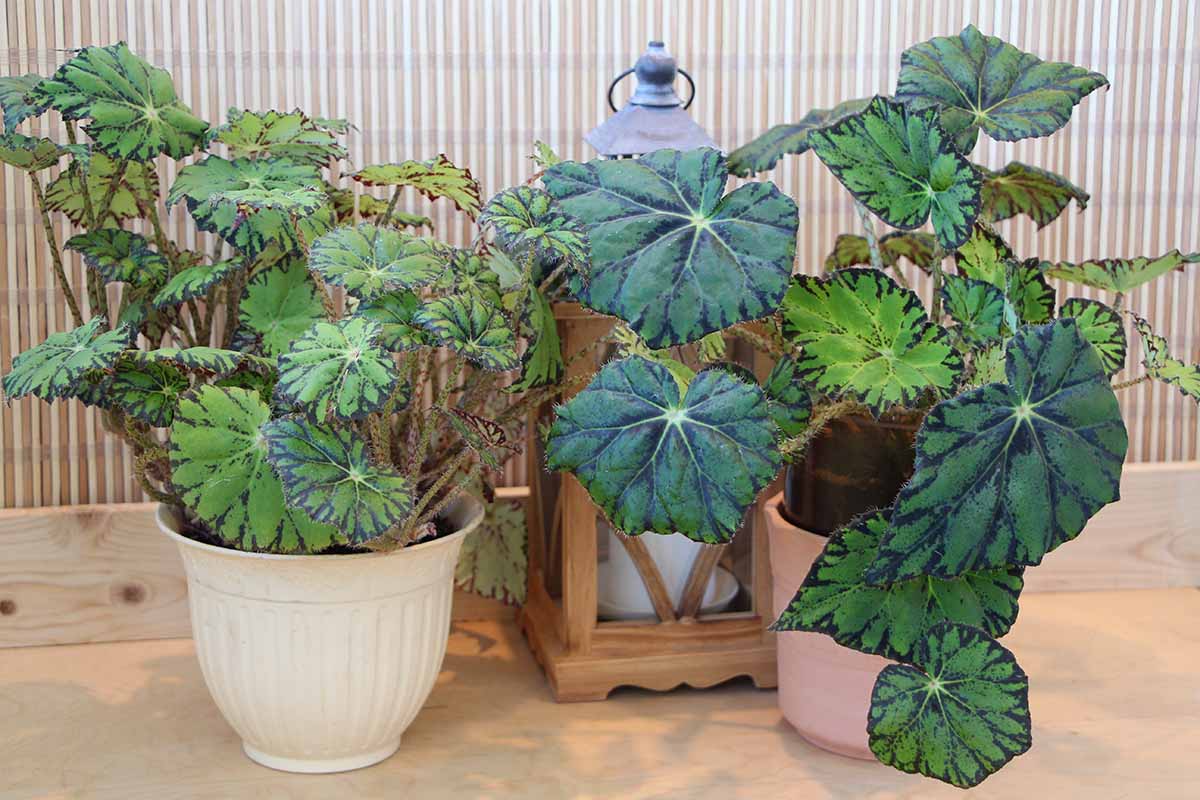
The spreading varieties look great in a hanging basket, while the upright types form a focal point in a group of indoor plants.
Maybe I’m an oddball, but I accidentally discovered that rex begonias can enliven the main bath decor. Two of my unnamed varieties are doing very well on the edge of my bathtub.
I moved them there during a remodeling project in the living room for what was supposed to be a week-long stay.
Between the humidity from the shower and the grow lights I have in there, that week has extended to a year and a half – so far. I must step over them to get in the tub, but that’s okay.
The beautiful plants are good companions when taking a stress-relieving warm bath, too.
Regarding companions, I don’t want to leave you without mentioning that rex begonias look dramatic and beautiful, but you don’t want to place too many of them near each other.
I think the reason some interior designers and indoor gardeners consider rex begonias gaudy is that they’re so often placed side by side without regard to their color scheme.
It’s difficult to appreciate those patterns and colors when they’re fighting for attention.
Instead, I like to pair or group these colorful foliage plants with leafy houseplants with single-shade leaves, like ‘Neon’ pothos or silver sword philodendron (Philodendron hastatum).
Of course, the companions also need to appreciate high humidity. Boston ferns, parlor palms, or alocasia are all solid choices.
Quick Reference Growing Guide
| Plant Type: | Herbaceous perennial foliage plant | Flower/Foliage Color: | Pink or white/Various multicolor combos including blood red, chocolate, cream, deep purple, hot pink, khaki, lavender, lime green, maroon, pink |
| Native to: | Cultivated hybrid | Maintenance: | Moderate to high |
| Hardiness (USDA Zones): | 10-12 | Tolerance: | Black walnut juglone, full or part shade (outdoors) |
| Exposure: | Bright light | Soil Type: | Porous, peat-based indoor growing mix |
| Time to Maturity: | 2-3 years | Soil pH: | 5.7-6.4 |
| Planting Depth: | Soil surface (seeds), rhizome’s top half visible above soil (cuttings), crown even with soil surface (varieties without rhizomes) | Soil Drainage: | Well-draining |
| Height: | 6-18 inches | Uses: | Hanging basket, houseplant, landscape (Zones 10-12), patio container garden, shaded deck, windowsills |
| Spread: | 6-18 inches | Order: | Cucurbitales |
| Growth Rate: | Fast | Family: | Begoniaceae |
| Water Needs: | Moderate | Genus: | Begonia |
| Common Pests and Diseases: | Mealybugs, spider mites; begonia leaf spot, botrytis, powdery mildew, root rot | Species: | Rex x cultorum |
Rex Begonia, King of Colorful Foliage
I don’t expect every indoor gardener to enjoy the colors and patterns of rex begonias as much as I do. But gosh, aren’t they wonderful?

I’d love to hear if you have a favorite variety of rex begonia or an experience or question you’d like to share. The comments section below is a welcoming space, so join in on the conversation there.
And then check out these begonia guides for more growing and care tips:
